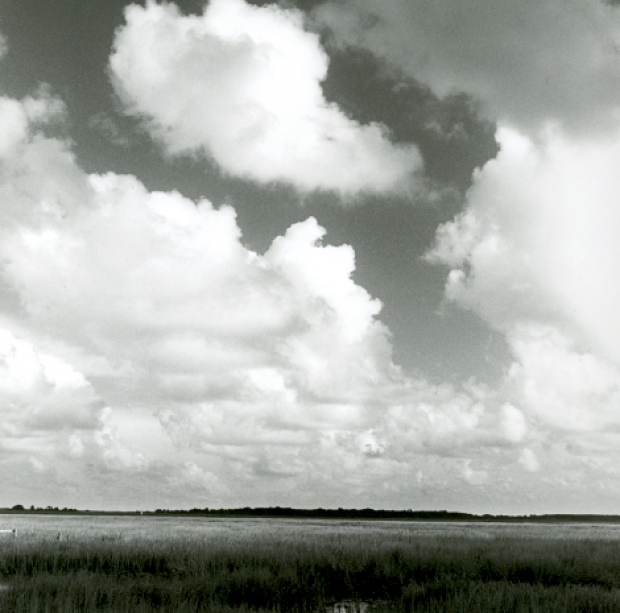Photographer Dina Hall sees through the landscape to a vision of human experience

Take a look at photographer Dina Hall’s work, and one might recognize the landscape–yes, it’s Murrells Inlet, and it’s breathtakingly beautiful. But take another look. What Hall is actually revealing are the cycles that make up our human experience: cycles of seasons, of weather, of time, of life.
Since Hall moved to her family’s Murrells Inlet fishing cottage in 1992, her professional work has documented the natural cycles of the marsh and inlet. She’s had great success in capturing the essence and evolution of the landscape, revealing the colors, views and textures that occur within seasonal and daily cycles. With her final photographic project, however, she’s exploring the cycle of people and culture: how lifestyles evolve, how they’re passed on and, when lost, how they might be found again.
A native South Carolinian, Hall spent most of her adult life in Rock Hill, teaching high school art, raising her three daughters, and spending summers at the family beach cottage. After earning an MFA in photography at Winthrop University, Hall moved to Murrells Inlet to become a lecturer at Coastal Carolina University. Over the next 15 years she taught art and photography at both CCU and Conway High School, and since 2007 she has focused exclusively on her own photography.
Many of Hall’s award-winning photographs focus on the ever-changing view from the back of her Murrells Inlet home. “My photographs are usually rooted in the landscape, particularly this coastal landscape,” Hall wrote in a recent autobiography. “I think I have been imprinted by this location.” In 2007, Hall embarked on a photographic journey to document the horizons and patterns of the inlet, taking a shot of the view each day of the year. The endeavor culminated in an accordion-style book titled “Times, Tides, Seasons: A Color Collection.” The series of 12 photographs that represent the inlet at various times each month won Best of Show in the 2007 Waccamaw Arts and Crafts Guild competition.
Another consistent theme in Hall’s work is the connection between natural elements and human subjects; she often juxtaposes portraits with natural images to draw parallels between human characteristics and the physical world. In her 2008 exhibit at CCU, titled “Landscape as Metaphor,” a shot of a waterfall was positioned next to a photo of Hall’s daughter, Hope, running in a race, to convey a common sense of power and energy. “Dina’s very interested in portraits,” said Alex Powers, a local artist and friend of Hall’s, “but she almost always poses the person outside, and she still sees the human life cycle as connected to other evolutionary cycles.”
Hall’s twin interests in establishing a sense of place and documenting natural cycles blend seamlessly in her latest project: a quilt designed as a legacy of the people of Rock Hill and its textile industry during the 1930s. The project began not as a series of photographs, but as a dusty old box of glass negatives that a Rock Hill art teacher found in her basement. Francis Lloyd presented the box to Hall in the 1980s, explaining that they were portraits of unidentified people, presumably taken at a portrait studio in the 1920s-1940s. To Hall, however, they were “fragile images–each a testament to the precise moment in the lives of these men, women and children.” Hall kept the negatives, “knowing that one day I would print the images in a way that would honor the subject and that time and place in which they were forever preserved.”
Hall developed the concept of the quilt about two years ago when, sadly, she was diagnosed with pancreatic cancer. She considers the craft a “bucket list” project, as she is determined that the lives and spirits depicted in the negatives be memorialized in a proper context. “The stories shouldn’t die,” Hall explains. “The stories–when you die and someone has no use for the glass plate negatives–what are they going to do with them? I wanted to find some way to tell the story.”
After cleaning and preserving the negatives, Hall printed the images onto vintage treated fabric using a traditional process called cyanotype. She traveled to Rock Hill to photograph the cotton fields to weave the images of people and place together using the products of the land–cotton and indigo–that were central to the textile industry of the period. Though the individuals represented remain unidentified, the quilt will celebrate their collective spirit, telling the story of a specific time and place in South Carolina history.
As Hall endures the final stages of her battle with cancer, she has high expectations for the future of her final artistic work: “My passionate hope is that as the quilt becomes part of the community, people will start to recognize faces, and we can begin to gather names and stories. Then the glass plates will have given up their secrets, and we can keep the memories true and well.”
Through this cultural artifact as well as the products of a prolific career in photography, Hall’s artistic vision of natural and human life as one continuous cycle will continue to impact audiences for decades to come.
Editor’s note: Dina Hall passed away in her Murrells Inlet home on Feb. 28. Her final project, the completed quilt, will be on display through April 28 at the Center for the Arts in Rock Hill as part of an exhibit titled “Quilts Tell Stories: an Exhibition of Historic and Contemporary Quilts.”